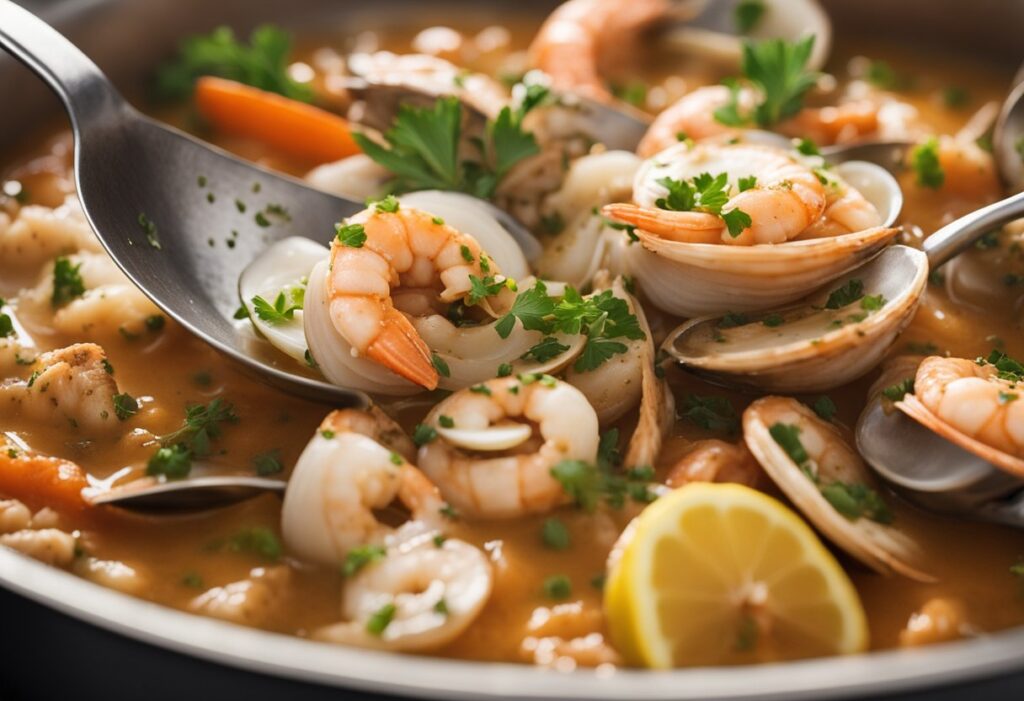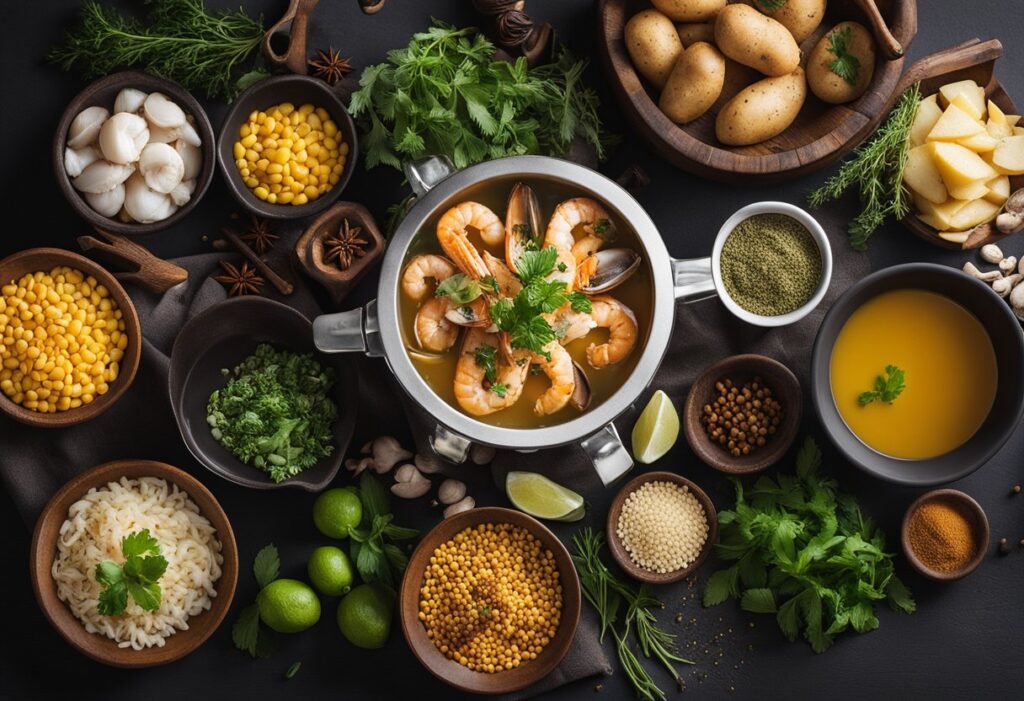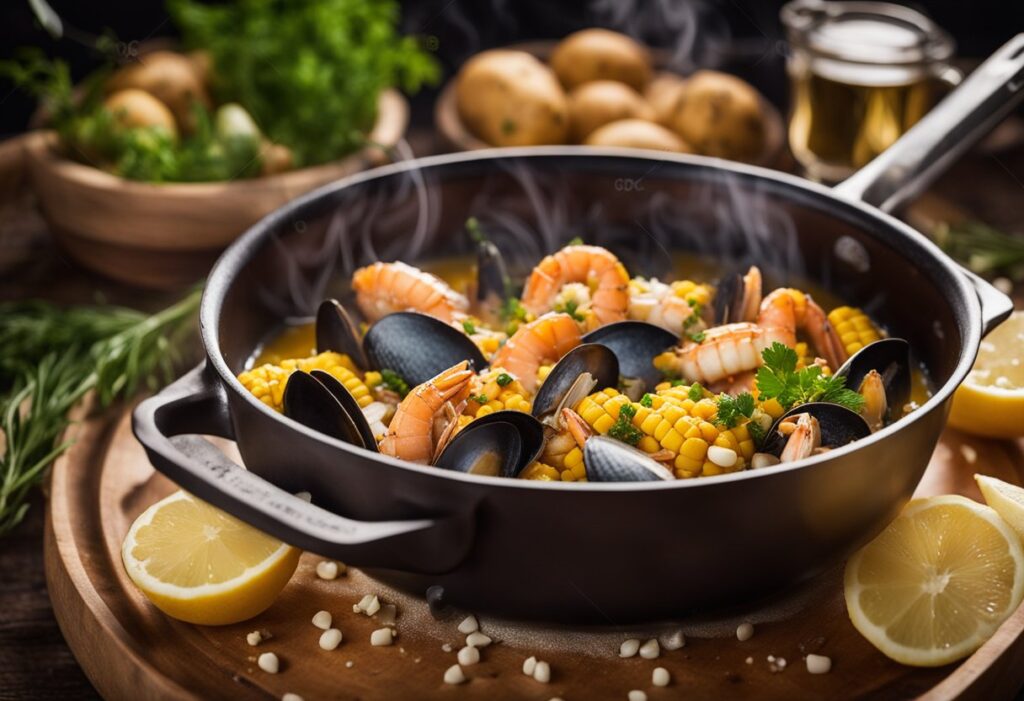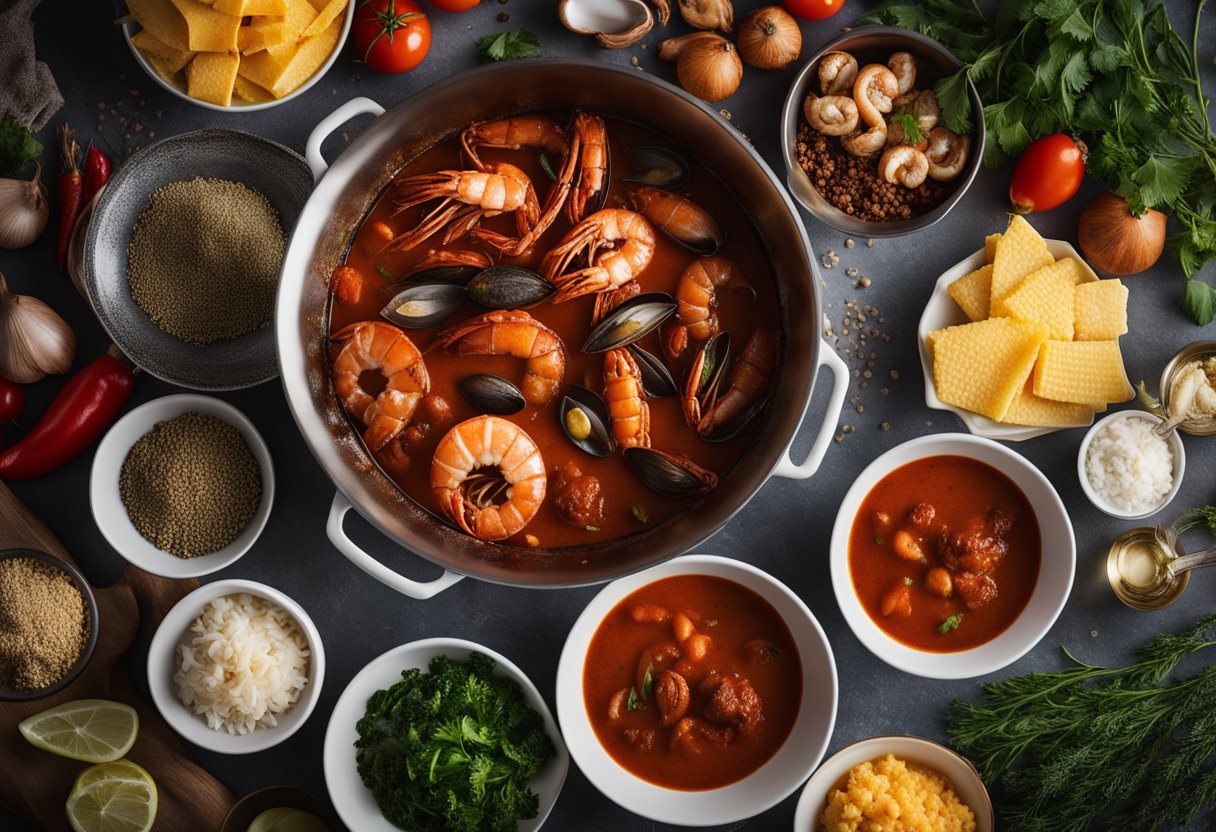Seafood boils are a beloved tradition in many coastal communities, with friends and family gathering around a table covered in newspaper to enjoy a feast of shrimp, crab, crawfish, and other seafood. But what really takes a seafood boil to the next level is the sauce. A good seafood boil sauce can elevate the flavors of the seafood and add a delicious kick of spice.
Table of Contents

Making a seafood boil sauce from scratch may seem daunting, but it’s actually quite simple. With a few key ingredients and some basic cooking techniques, anyone can create a delicious seafood boil sauce that will impress their guests. In this article, we’ll provide a step-by-step guide to creating a flavorful seafood boil sauce that will take your boil to the next level. Whether you prefer a classic Cajun-style sauce or something with a little more heat, we’ve got you covered. So grab your seafood and let’s get cooking!
Essential Ingredients for Seafood Boil Sauce
Seafood boil sauce is the perfect accompaniment to any seafood boil. The sauce adds flavor and depth to the seafood, making it a delicious and satisfying meal. Here are some essential ingredients that should be included in any seafood boil sauce recipe:
1. Butter
Butter is a crucial ingredient in seafood boil sauce. It adds a rich and creamy flavor to the sauce and helps to thicken it as well. Unsalted butter is preferred so that the cook can control the amount of salt in the sauce.
2. Garlic
Garlic is a staple ingredient in many seafood boil sauce recipes. It adds a pungent flavor and aroma to the sauce and complements the seafood well. Fresh garlic is preferred, but garlic powder can also be used.
3. Lemon Juice
Lemon juice is a key ingredient in seafood boil sauce. It adds a bright and tangy flavor to the sauce and helps to cut through the richness of the butter. Freshly squeezed lemon juice is preferred.
4. Worcestershire Sauce
Worcestershire sauce is a savory and tangy sauce that adds depth and complexity to seafood boil sauce. It is made from a blend of vinegar, molasses, anchovies, and various seasonings. A little bit goes a long way, so use it sparingly.
5. Hot Sauce
Hot sauce is an optional ingredient in seafood boil sauce, but it adds a nice kick of heat and flavor. Choose a hot sauce that complements the flavors of the seafood and the other ingredients in the sauce.
6. Old Bay Seasoning
Old Bay seasoning is a classic seasoning blend that is commonly used in seafood boil sauce recipes. It is a blend of celery salt, paprika, black pepper, and other spices, and it adds a delicious and unique flavor to the sauce.
These essential ingredients can be combined in various proportions to create a delicious and flavorful seafood boil sauce. Experiment with different combinations to find the perfect balance of flavors for your taste.
Choosing Your Seafood

Crustaceans
When it comes to seafood boils, crustaceans are a must-have. These creatures are typically high in protein and low in fat, making them a healthy addition to your meal. Here are some popular crustaceans to consider when choosing your seafood:
- Shrimp: Shrimp is a classic seafood boil ingredient. It’s easy to cook and has a mild flavor that pairs well with bold spices and seasonings.
- Crawfish: Crawfish, also known as crayfish or mudbugs, are a Southern favorite. They have a sweet, delicate flavor and are best enjoyed during crawfish season (January to June).
- Crab: Crab is another popular seafood boil ingredient. It’s meaty and flavorful, and can be cooked in a variety of ways, from steaming to boiling.
Shellfish
Shellfish are another delicious addition to seafood boils. They’re typically lower in fat and calories than other types of seafood, and they’re a good source of protein and other nutrients. Here are some popular shellfish to consider when choosing your seafood:
- Clams: Clams are a versatile shellfish that can be cooked in a variety of ways. They have a sweet, briny flavor and pair well with garlic, butter, and other seasonings.
- Mussels: Mussels are another popular shellfish that are easy to cook and have a mild, sweet flavor. They’re often served with a garlic or tomato-based sauce.
- Lobster: Lobster is a luxurious addition to any seafood boil. It’s meaty and flavorful, and pairs well with butter, lemon, and other citrus flavors.
When choosing your seafood, it’s important to consider the freshness and quality of the ingredients. Look for seafood that is firm, shiny, and has a mild, ocean-like scent. Avoid seafood that smells fishy or has a slimy texture. With these tips in mind, you’ll be able to choose the perfect seafood for your next seafood boil.
Preparing the Base
Creating a Roux
To start making the perfect seafood boil sauce, it is important to create a roux. A roux is a mixture of equal parts fat and flour, which is cooked until it reaches a desired color and consistency. The roux serves as the base for the sauce and helps to thicken it.
To create a roux for the seafood boil sauce, one can use butter or oil as the fat and all-purpose flour. The roux should be cooked over medium heat, stirring constantly until it reaches a light brown color. It is important to continuously stir the roux to prevent it from burning and to ensure an even color.
Selecting a Liquid
After creating the roux, the next step is to select a liquid to add to the base. The liquid can be water, seafood broth, beer, or a combination of any of these. The liquid should be added slowly to the roux, while continuously stirring to prevent lumps from forming.
The amount of liquid added will depend on the desired consistency of the sauce. For a thicker sauce, less liquid should be added, while for a thinner sauce, more liquid should be added. It is important to note that the liquid should be added gradually to ensure that the sauce does not become too thin or too thick.
In conclusion, creating a roux and selecting a liquid are essential steps in preparing the base for a delicious seafood boil sauce. By following these steps, one can create a flavorful and perfectly thickened sauce that will enhance the flavors of any seafood dish.
Seasoning Mix

Spices and Herbs
The seasoning mix is the heart of any seafood boil sauce recipe. It is what gives the dish its unique flavor and aroma. The spices and herbs used in the mix can vary depending on personal preference, but some of the most common ones include garlic, onion, bay leaves, thyme, and parsley. These ingredients are often combined with other spices like cayenne pepper, paprika, and black pepper to add some heat.
To make the seasoning mix, simply combine all the spices and herbs in a bowl and mix well. It is important to use fresh herbs and spices to ensure that the seasoning mix is as flavorful as possible. Once the mix is ready, it can be added to the seafood boil sauce to infuse the dish with its distinctive taste.
Adjusting Heat Levels
One of the great things about making your own seafood boil sauce is that you can adjust the heat levels to your liking. If you prefer a milder sauce, simply reduce the amount of cayenne pepper or omit it altogether. On the other hand, if you like your sauce spicy, you can add more cayenne pepper or even some hot sauce.
Another way to adjust the heat levels is to use different types of peppers. For example, if you want a smoky flavor, you can use chipotle peppers instead of cayenne. Alternatively, if you want a fruity flavor, you can use habanero peppers.
It is important to note that when adjusting the heat levels, it is best to do so gradually. Add a little bit of spice at a time and taste the sauce to see if it is to your liking. This way, you can avoid making the sauce too spicy and ruining the flavor.
Cooking Techniques
Simmering Basics
Simmering is a cooking technique that involves cooking food in liquid at a temperature just below boiling. This technique is often used when making seafood boil sauce because it allows the ingredients to cook slowly and infuse the sauce with flavor.
To simmer seafood boil sauce, start by bringing the liquid to a boil and then reducing the heat to a low simmer. Make sure to stir the sauce occasionally to prevent it from sticking to the bottom of the pot.
Sauce Thickness
The thickness of seafood boil sauce can vary depending on personal preference. Some people prefer a thicker sauce while others prefer a thinner sauce.
To thicken seafood boil sauce, add a slurry of cornstarch and water to the sauce while it is simmering. Make sure to whisk the slurry together before adding it to the sauce to prevent clumps.
To thin seafood boil sauce, simply add more liquid to the sauce. This can be done using water, broth, or even beer.
Overall, simmering and adjusting the thickness of seafood boil sauce are important techniques to master in order to create a delicious and flavorful sauce.
Flavor Enhancements
Citrus and Vinegars
Adding citrus and vinegar to the seafood boil sauce can enhance the flavors and provide a fresh, tangy taste. Lemon juice, lime juice, and orange juice are popular choices for citrus flavors, while white or apple cider vinegar are common vinegar choices.
To incorporate citrus and vinegar into the sauce, start with small amounts and taste as you go. Too much acidity can overpower the other flavors in the sauce. A good rule of thumb is to use one tablespoon of citrus or vinegar per cup of sauce.
Umami Boosters
Umami is the savory taste that is often described as meaty or brothy. Adding umami boosters to the seafood boil sauce can deepen the flavors and provide a more complex taste. Soy sauce, Worcestershire sauce, and fish sauce are all great umami boosters.
To incorporate umami boosters into the sauce, start with small amounts and taste as you go. Too much umami can make the sauce too salty or overpowering. A good rule of thumb is to use one to two teaspoons of umami booster per cup of sauce.
Using a combination of citrus, vinegar, and umami boosters can create a well-rounded and flavorful seafood boil sauce. Experiment with different ratios and combinations to find the perfect balance for your taste buds.
Remember to always taste the sauce as you go and adjust the ingredients accordingly. With these flavor enhancements, your seafood boil sauce will be sure to impress your guests.
Serving Suggestions
Accompaniments
Seafood boils are often served with a variety of accompaniments to enhance the flavor and texture of the dish. Some popular accompaniments include corn on the cob, potatoes, and sausage. These ingredients are often boiled in the same pot as the seafood and absorb the flavors of the sauce.
Another popular accompaniment is garlic bread. The buttery, garlicky bread is perfect for soaking up the flavorful sauce. A simple salad with a light vinaigrette dressing can also be served to balance out the richness of the seafood boil.
Presentation Tips
Presentation can make a big difference in the overall dining experience. Serving the seafood boil in a large, communal pot is a popular way to present the dish. This allows guests to serve themselves and creates a festive atmosphere.
Another option is to serve the seafood boil on a large platter with the seafood arranged in a visually appealing way. Garnishing the platter with fresh herbs or lemon wedges can add color and flavor to the dish.
When it comes to utensils, providing guests with shell crackers, seafood forks, and napkins is essential. Seafood boils can be messy, so it’s important to have plenty of napkins on hand.
Overall, serving a seafood boil with a variety of accompaniments and presenting it in an appealing way can elevate the dining experience and impress guests.
Storage and Reheating Instructions
After enjoying a delicious seafood boil, it’s important to know how to properly store and reheat any leftovers. Here are some tips to ensure that your seafood boil stays fresh and tasty:
- Store any leftover seafood in an airtight container in the refrigerator. It’s best to eat any leftovers within 2-3 days to ensure freshness.
- Store any leftover sauce separately from the seafood. The sauce can be stored in a separate airtight container in the refrigerator for up to 1 week.
- To reheat the seafood, bring a pot of water to a boil and add the seafood. Heat the seafood for 2-3 minutes or until heated through.
- To reheat the sauce, simply microwave it for 30 seconds to 1 minute or until heated through.
- It’s important to note that seafood should only be reheated once. Any additional reheating can lead to a loss of quality and potential foodborne illness.
By following these simple storage and reheating instructions, you can enjoy your seafood boil for days to come without sacrificing taste or quality.
Customization Ideas
Regional Variations
Seafood boil sauces can vary greatly depending on the region. In Louisiana, for example, a traditional seafood boil sauce may include ingredients such as cayenne pepper, garlic, and lemon juice. In the Northeastern United States, a seafood boil sauce may include ingredients such as Old Bay seasoning, vinegar, and mustard.
If you want to customize your seafood boil sauce to match a specific region, do some research on the traditional ingredients and flavor profiles of that area. You can experiment with different spices, herbs, and sauces to create a unique flavor that represents the region you’re trying to emulate.
Dietary Adjustments
For those with dietary restrictions, there are plenty of ways to customize a seafood boil sauce recipe. For example, if you’re following a low-carb or keto diet, you can substitute sugar with a low-carb sweetener such as erythritol or stevia. If you’re following a vegan or vegetarian diet, you can omit the seafood and use vegetables such as cauliflower or mushrooms instead.
If you have food allergies, be sure to read ingredient labels carefully and adjust the recipe accordingly. For example, if you’re allergic to shellfish, you can substitute shrimp and crab with other types of seafood such as fish or squid.
Overall, there are endless ways to customize a seafood boil sauce recipe to suit your preferences and dietary needs. With a little creativity and experimentation, you can create a delicious and unique sauce that’s perfect for your next seafood boil.

